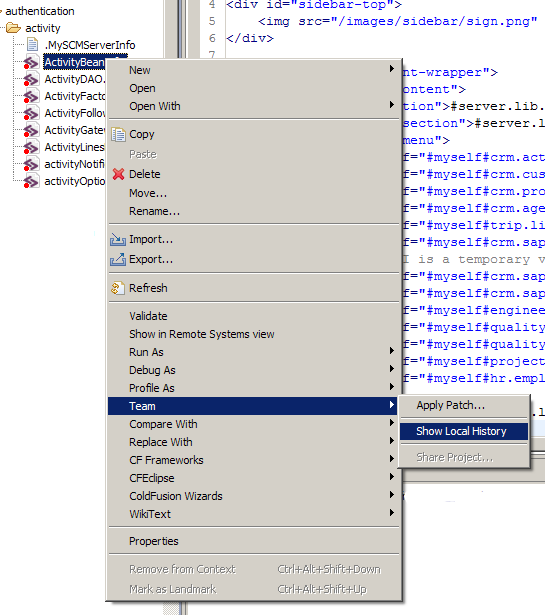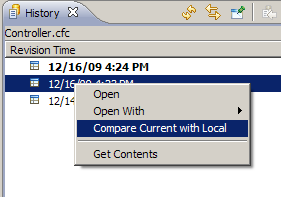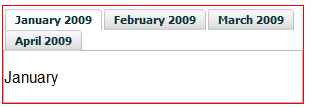I just found out I was accepted into the Adobe Community Professionals program for 2010. I hope I can be a good resource for the ColdFusion community. I look forward to continuing to blog and discuss ColdFusion. The CfObjective conference in Minneapolis is just a few months away. I’ll be there, come say hello if you see me.
Here is the announcement http://lizfrederick.blogspot.com/2010/01/new-acps-for-2010.html
Posted by Ryan Stille on January 18 2010 at 8:54 pm under ColdFusion.
3 Comments.
One of the things I’ve noticed as I’ve been working on our ColdFusion 9 upgrade is that many of the UI components look different than they did in ColdFusion 8. In many cases I’m sure this won’t be a problem. But my user base is fairly picky, and I think the CF8 to CF9 transition should be seamless to them. The tabs in CF9 look quite a bit different than they do in CF8.
Continue reading ‘Making ColdFusion 9 tabs look similar to CF8 tabs’ »
Posted by Ryan Stille on January 16 2010 at 10:12 pm under ColdFusion, CSS.
2 Comments.
A friend asked me for some help the other day. At the place he works at they use IIS on their production servers, but each developer works locally using Apache. Why use different webservers for production and development? He said they do it because its easier to develop locally with Apache. My guess is its easier because you can run multiple sites at once with Apache. With IIS on a desktop machine you can only run one site at a time. I do the exact same thing at my job, actually.
Anyway, once in a while this causes issues. In this case, there was code on the server that required a username and password in order to access the page. The security was done at the web server level, aka “HTTP authentication”, which causes your browser to prompt you for a username and password. These credentials then get sent along in the request headers (its actually a little more complicated than that but I won’t get into that here). After authenticating, the username is available to ColdFusion as a CGI variable – CGI.REMOTE_USER.
When using IIS, that value is also available as CGI.AUTH_USER. In all CGI variable specs I could find, they all reference REMOTE_USER, not AUTH_USER, I’m not sure when AUTH_USER started to be used. Anyway, this ColdFusion code running on the IIS server would look to the CGI.AUTH_USER variable and display some things differently depending on who the user was.
This posed a problem when trying to run this code locally under apache. The CGI.AUTH_USER variable did exist, but it was always blank. One could change the code to use the more multi-platform friendly “REMOTE_USER”, but sometimes there are hurdles to changing existing code.
But there is a way to mimic the behavior of IIS, by copying the REMOTE_USER value into AUTH_USER. Its only three simple lines but it took me quite a while to figure this out.
RewriteEngine on
RewriteCond %{REMOTE_USER} (.*)
RewriteRule .* - [E=AUTH_USER:%1]
You’ll need to have mod_rewrite enabled of course. Usually all you need to do is uncomment a line that looks like this in httpd.conf:
LoadModule rewrite_module modules/mod_rewrite.so
The three magic lines can go into the httpd.conf file, or you could place them in a .htaccess file in the directory you’re working in.
Posted by Ryan Stille on January 9 2010 at 3:50 pm under ColdFusion, Linux, Web Development.
2 Comments.
I had an issue recently when I was working with a couple other developers on a project. We keep our MySQL database in sync by exporting the database as an SQL script and sharing it in a subversion repository (I wish MS SQL could be this easy!). Our table names are saved with mix case, like “userFiles”, but everytime I would export my database the tables would come out all lower case, like “userfiles”.
Turns out this is a simple thing to fix, I had to add a line to MySQL’s config file: my.cnf. Mine was located at [MySQL installed root]\bin\my.cnf. The setting that needs to change is lower_case_table_names, I set the value to 2, like this:
lower_case_table_names=2
If you are interested, here are the different possible values:
| Value |
Meaning |
| 0 |
Table and database names are stored on disk using the lettercase
specified in the CREATE TABLE or CREATE DATABASE statement. Name comparisons are case
sensitive. Note that if you force this variable to 0 with –lower-case-table-names=0
on a case-insensitive file system and access MyISAM tablenames using different
lettercases, index corruption may result. |
| 1 |
Table names are stored in lowercase on disk and name comparisons are not
case sensitive. MySQL converts all table names to
lowercase on storage and lookup. This behavior also
applies to database names and table aliases. |
| 2 |
Table and database names are stored on disk using the lettercase
specified in the CREATE TABLE or CREATE DATABASE statement, but MySQL converts them to
lowercase on lookup. Name comparisons are not case sensitive. This works only on file
systems that are not case sensitive! InnoDB table names are stored in
lowercase, as for lower_case_table_names=1. |
On Windows the default is 1.
More information at http://dev.mysql.com/doc/refman/5.0/en/identifier-case-sensitivity.html
Posted by Ryan Stille on January 3 2010 at 11:24 am under SQL, System Administration.
2 Comments.
Today a coworker asked me if I knew how to recover a deleted file in CFEclipse. He had accidentally deleted it before putting into his source control. Since he had been working on this file recently, there is a way to recover it.
By default Eclipse keeps a local history of the files you work on. From within Eclipse, right click on a file and select Team->Show Local History.

From here you will get a list of revisions, generally one is made each time you save the file. You can open a revision, or even use a built in diff tool to compare it to your current version.

But in this case we had no current version to even right click on to start the process. So we simply created a new, empty file in the same location as the old one. Then we were able to right click on it and pull up the history.
This local history is stored under your workspace in workspace\.metadata\.plugins\org.eclipse.core.resources\.history, but its not easy to manually browse. There any many directories and the files in those directories are given nonsense file names. Much easier to stick with the Eclipse interface.
Keep in mind that if you haven’t edited the file in a while there may not be any history to go to.
Posted by Ryan Stille on December 16 2009 at 10:25 pm under ColdFusion, Web Development.
1 Comment.
The other day I had the need to align some data in an html cfgrid. There are some alignment attributes of the cfgriditem tag, but they do not work in html grids. I tried wrapping the data in a span tag with some css aligning it, but that didn’t work either.
But there is a way. When CF8 generates the grid it writes out CSS ids and classes that you can use to style the grid. For example to right align the 5th column you can use this:
.x-grid-td-5 {text-align:right;}
The number you need to use in the class name does not always match up with the column. Sometimes I had to use .x-grid-td-8 to reference the 6th column for example. I think the number increments for each cfgrid item, even if you have display=no.
If you have more than one cfgrid on your page and only want to align the nth column in one of them, you can wrap the cfgird in a div with an ID so you can reference only that grid in your CSS.
Posted by Ryan Stille on September 27 2009 at 9:35 pm under ColdFusion, Uncategorized, Web Development.
1 Comment.
I just discovered a neat feature of CF9. Sometimes when calling a built in function or even a custom method, you get returned an array. But sometimes you only need one element in that array. In Perl and other languages its possible to directly access the element you want. I’m glad to see this has been added to ColdFusion9.
For example, lets say you need the second particular element in an XML document. You might fetch some XML with cffeed and then use XMLSearch() to get all the matching elements. Then reference the second element of the resulting array, like this:
Continue reading ‘Referencing returned value array values in CF9’ »
Posted by Ryan Stille on September 14 2009 at 10:06 pm under ColdFusion, Railo, Uncategorized.
Comments Off on Referencing returned value array values in CF9.
If you’ve used the new CF8 UI features to create tabs, you may have run into an issue when you have a lot of them. By default the tabs will not wrap. Take this snippet of code for example. I’ve added a red border on this 300 pixel div so you can see the tabs won’t wrap inside of it:
<div style="font-family: arial; width: 300px; border: 1px solid red;">
<cflayout type="tab" name="myTabs">
<cflayoutarea name="january" title="January 2009">
<p>January</p>
</cflayoutarea>
<cflayoutarea name="february" title="February 2009">
<p>February</p>
</cflayoutarea>
<cflayoutarea name="march" title="March 2009">
<p>March</p>
</cflayoutarea>
<cflayoutarea name="april" title="April 2009">
<p>April</p>
</cflayoutarea>
</cflayout>
</div>
Imagine that 300 pixel div is your normal content area – it could be a table or just the width of your browser. Take a look at what it produces in your browser:

In ColdFusion 8 (this might change in CF9?) the tabs generated by cflayout are table data cells. It would be pretty hard to cause table data cells to wrap within a set of <tr></tr> tags wouldn’t you think? It actually is possible though. If you add this snippet of CSS:
<style type="text/css">
.x-tabs-strip tr {display:block}
.x-tabs-strip td {display:block; float:left}
.x-tabs-strip .on .x-tabs-inner {padding-bottom:4px}
</style>
You’ll see the tabs now look like this:

If you want to force the tabs to be a specific width, add one more line:
<style type="text/css">
.x-tabs-strip tr {display:block}
.x-tabs-strip td {display:block; float:left}
.x-tabs-strip .on .x-tabs-inner {padding-bottom:4px}
.x-tabs-wrap table {width:400px}
</style>
In most JavaScript frameworks tabs are done using list elements (<li> tags) inside an unordered list (<ul> tag). This approach is much more flexible. It will be interesting to see what changes are made to the html generated by the layout tags in ColdFusion9.
Update 1/4/2010 – The method described above does NOT work in CF9. The tabs generated in CF9 are done using a much newer version of EXT. They are no longer based on table data cells, instead they use list items ( <li> tags), like most tab implementations. Use this CSS to wrap the tabs in CF9.
Posted by Ryan Stille on August 12 2009 at 8:09 pm under ColdFusion, CSS, Web Development.
8 Comments.
One of the new features I am excited to see in ColdFusion 9 is support for anonymous arrays. I’ve used these before in PHP, Perl, and other languages, and I’m glad to see them added to ColdFusion.
I blogged about this issue in 2007. I was trying to add a column to an existing array that I knew only had one row. QueryAddColumn() accepts an array of values to add to an existing query – one element for each row. So I only needed an array with one element. So I thought I could use CF8’s new inline array syntax and just pass it in like this:
<cfset QueryAddColumn(existingQuery,
"newColName",
"varchar",
["single new value"])>
This would throw an error in CF8, but works just fine in CF9!
By the way this also works just fine in the current version of Railo.
Posted by Ryan Stille on August 4 2009 at 7:08 am under ColdFusion, Railo, Web Development.
Comments Off on Anonymous arrays in ColdFusion 9.
Did you know there is a “format” attribute for the cfdump tag? The default format is html, but you can also pass in a format of “text”. I’ve found this useful for putting data structures into plain text emails, logs files, and other things.
For example, this code:
<cfset tmp.fname = "John">
<cfset tmp.lname = "Smith">
<cfset tmp.age = 26>
<cfset tmp.city = "Omaha">
<cfset tmp.state = "Nebraska">
<cfdump var="#tmp#" format="text">
Produces this output:
struct
AGE: 26
CITY: Omaha
FNAME: John
LNAME: Smith
STATE: Nebraska
It works for complex structures, too:
<cfset tmp.person1.fname = "John">
<cfset tmp.person1.lname = "Smith">
<cfset tmp.person1.age = 26>
<cfset tmp.person1.city = "Omaha">
<cfset tmp.person1.state = "Nebraska">
<cfset tmp.person1.pets = ['Fluffy','Mr. Jingles','Bambi']>
<cfset tmp.person2.fname = "Mary">
<cfset tmp.person2.lname = "Doogan">
<cfset tmp.person2.age = 32>
<cfset tmp.person2.city = "Kansas City">
<cfset tmp.person2.state = "Missouri">
<cfset tmp.person2.pets = []>
<cfdump var="#tmp#" format="text">
Produces this output:
Struct
PERSON2 Struct
AGE number 32
LNAME string Doogan
PETS Array
STATE string Missouri
CITY string Kansas City
FNAME string Mary
PERSON1 Struct
AGE number 26
LNAME string Smith
PETS Array
1 string Fluffy
2 string Mr. Jingles
3 string Bambi
STATE string Nebraska
CITY string Omaha
FNAME string John
Railo also supports the “format” attribute, but BlueDragon does not. In fact Railo supports a bunch of interesting attributes to the cfdump tag.
Posted by Ryan Stille on July 27 2009 at 7:03 am under ColdFusion, Web Development.
3 Comments.





